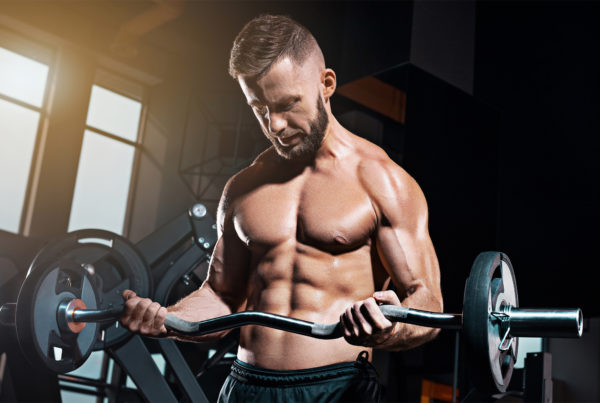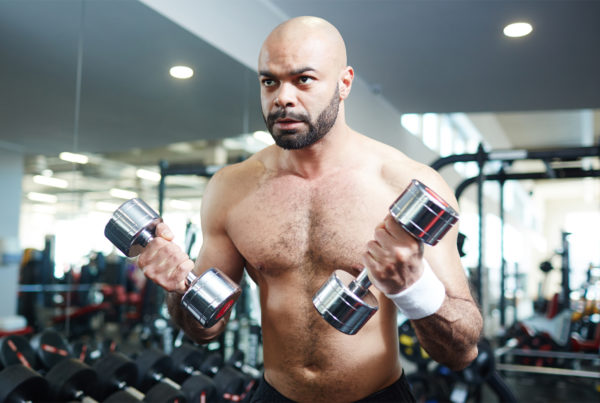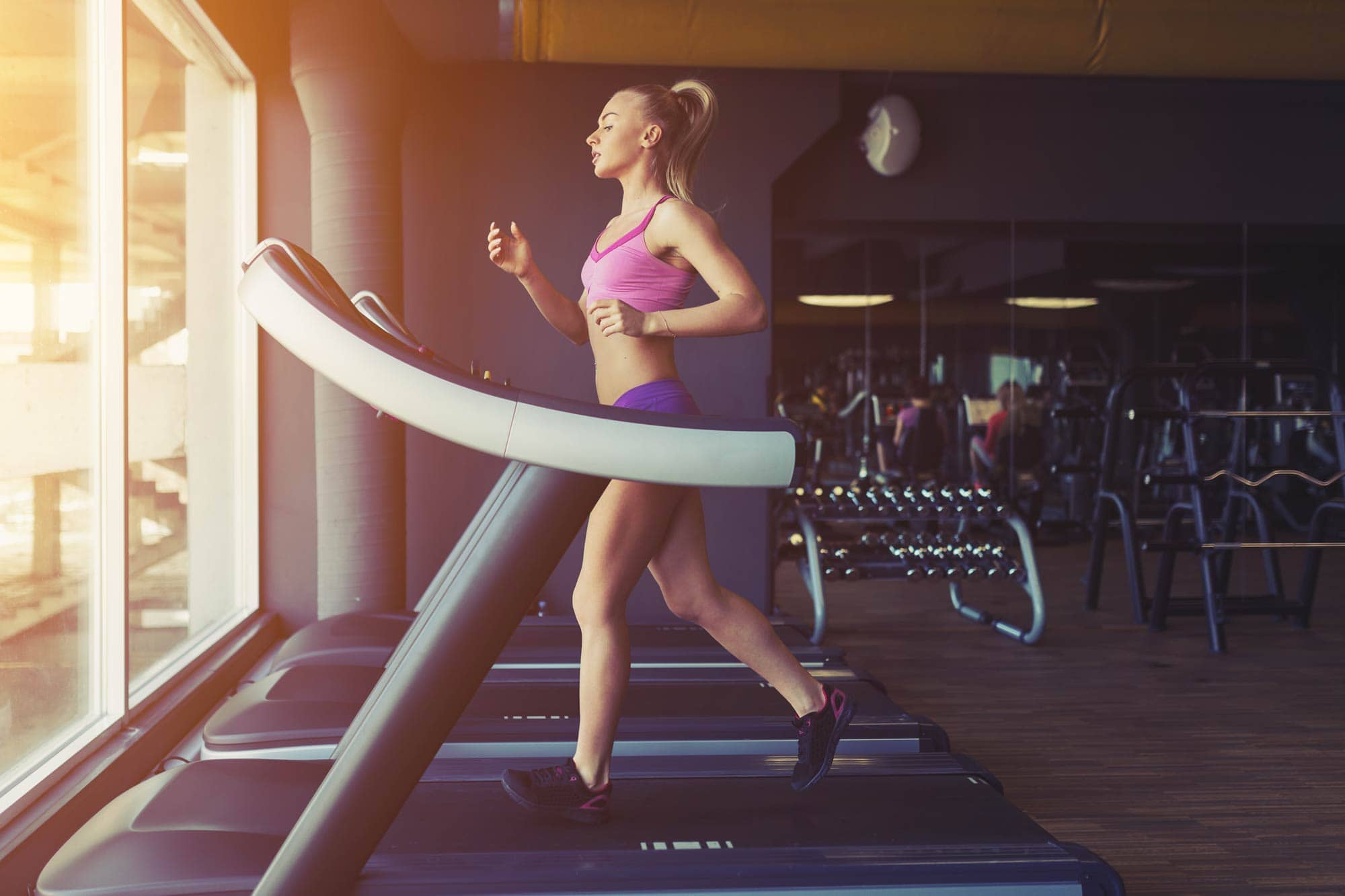
Trying to figure out what the “best” machine is when doing cardio at the gym can prove to be a difficult task since everyone’s opinions vary so greatly on the topic. However, with personal opinions aside, choosing the best machine for cardio is actually quite simple.
The Short Answer:
The best cardio machine at the gym is the one that 1) plays to your current fitness level and goals; 2) challenges your heart and improves your cardiovascular health; 3) burns an efficient amount of calories (and therefore fat) each workout; and 4) provides you with at least some sort of level of enjoyment.
The most commonly available cardio machines that meet these criteria are:
- Elliptical
- Treadmill
- Stationary Bike
- Rowing Machine
- Stair Stepper
Everybody’s Got Their Own Opinion
As you probably already know, figuring out the “best” cardio machine to use can get very confusing very fast since you’ve got many different options to choose from: treadmill, elliptical, stair stepper, stationary bike, rowing machine, Jacobs Ladder, air bike, ARC trainer, recumbent bike, etc.
Add that to the fact that everyone’s got a different opinion on what works best based on some silly new studies — all of which contradict each other and prove nothing — and you’ll be even more confused.
Still wondering, “Ummm… so which one is the best?” or “How exactly do I figure out which one is the best for me?” Well, buckle up because that’s exactly what I’m going to discuss here.
By the end of this article, my hope is that you’ll be able to make a firm decision on which cardio machine is the best for YOU and also that you’ll have a better understanding on exactly how to use each machine to get better results.
When you’re done reading, leave a comment down below to let me know if I succeeded with that. And if I didn’t, then let me know why. That way I can improve this article to help more people just like yourself. 😃
Here are the cardio machines we’ll cover in this article:
Note: Listed in order of least effectiveness, saving the best for last.
Feel free to use the navigation box above to skip ahead at your leisure. However, if you want to gain a bit more perspective on the logic behind my decisions, I highly suggest that you continue reading along.
Machine Cardio Is a Pain in the Ass
I haven’t met a tonne of people who say to me, “I absolutely love doing machine cardio at the gym!” No, seriously! I’ve met maybe a handful at most — my mom is actually one of them — that feel this way but they’re obviously born from a rare breed. 😄
The fact is that machine cardio kinda sucks; however, it’s necessary for good heart health — especially during the winter months when you can’t get outside.
So here’s the thing: If you’re going to dedicate any amount of time to doing it multiple times per week, wouldn’t you rather that you do so in the most efficient way possible? Wouldn’t it be good to know the best machines to use and why?
Well, that’s exactly what I’m going to discuss with you today based on my experience and the experiences of my clients.
Why Is One Cardio Machine Better than the Other?
Firstly, it’s mostly a matter of personal opinion, which is what I will be expressing here today. This is one of the most widely debated topics in fitness and there really is no clear-cut winner.
Most would argue that the best machine is the one that burns the most calories, but since scientists can’t even figure that out accurately enough, that’s not what we’ll discuss here today. In my opinion, there are really three key factors that need to be present to determine the “best” cardio machine. Here they are:
- Is it improving your heart health or maintaining good heart health?
- Is it burning an efficient amount of calories per training session?
- Is there a general level of enjoyment while you’re using it?
With all of that being said, it’s still not enough for me to just start listing off a bunch of machines from worst to best that meet these criteria because how you utilize these machines also plays a HUGE factor in their efficiency rating — so pay close attention to the details.
Also, although I’m only going to cover the most popular and widely-used cardio machines in this article, if you have any questions at all about other specific equipment, leave a comment below and I’ll be sure to chime in!
Disclaimer
Before we begin, I suppose it’s also important to note that my opinion here is also a bit biased towards using cardio simply as a means of improving heart health and burning some extra calories while preserving hard-earned muscle mass via resistance training.
Personally, I think this is the main reason anyone should be using machines for cardio in the first place. If you’re an advanced trainer or involved in sport-specific training, there are much better ways to improve your cardio and overall endurance.
Also, I’m not a huge advocate of doing cardio for hours on end each day as a means of losing weight or burning fat. If that’s your goal — and you want to have lasting results — you have to adopt a lifestyle that consists of using a finely-tuned combination of cardio, resistance training, and good eating habits.
You will also not find any gimmicky “calories burned per minute” statistics in this article because all of that stuff is BS. The amount of calories you burn on each machine is dependent upon a number of factors, including: how you’re using the machines, how hard your heart is working, and your fitness level with that particular machine.
P.S. Don’t ever pay attention to the “calories burned” number that the machine spits out. It’s never really going to be accurate. Instead, pay attention to how you feel and whether or not you’re actually challenging yourself.
P.P.S. Just because you’re sweating a lot, it doesn’t mean you’re working “really hard”. I know tonnes of people who sweat profusely while sitting on the couch watching TV. I’m one of them! 😅
OK. Enough disclaimers, let’s dive in already.
1. Elliptical
Level of Difficulty: Easy to Medium | Focus: Full Body
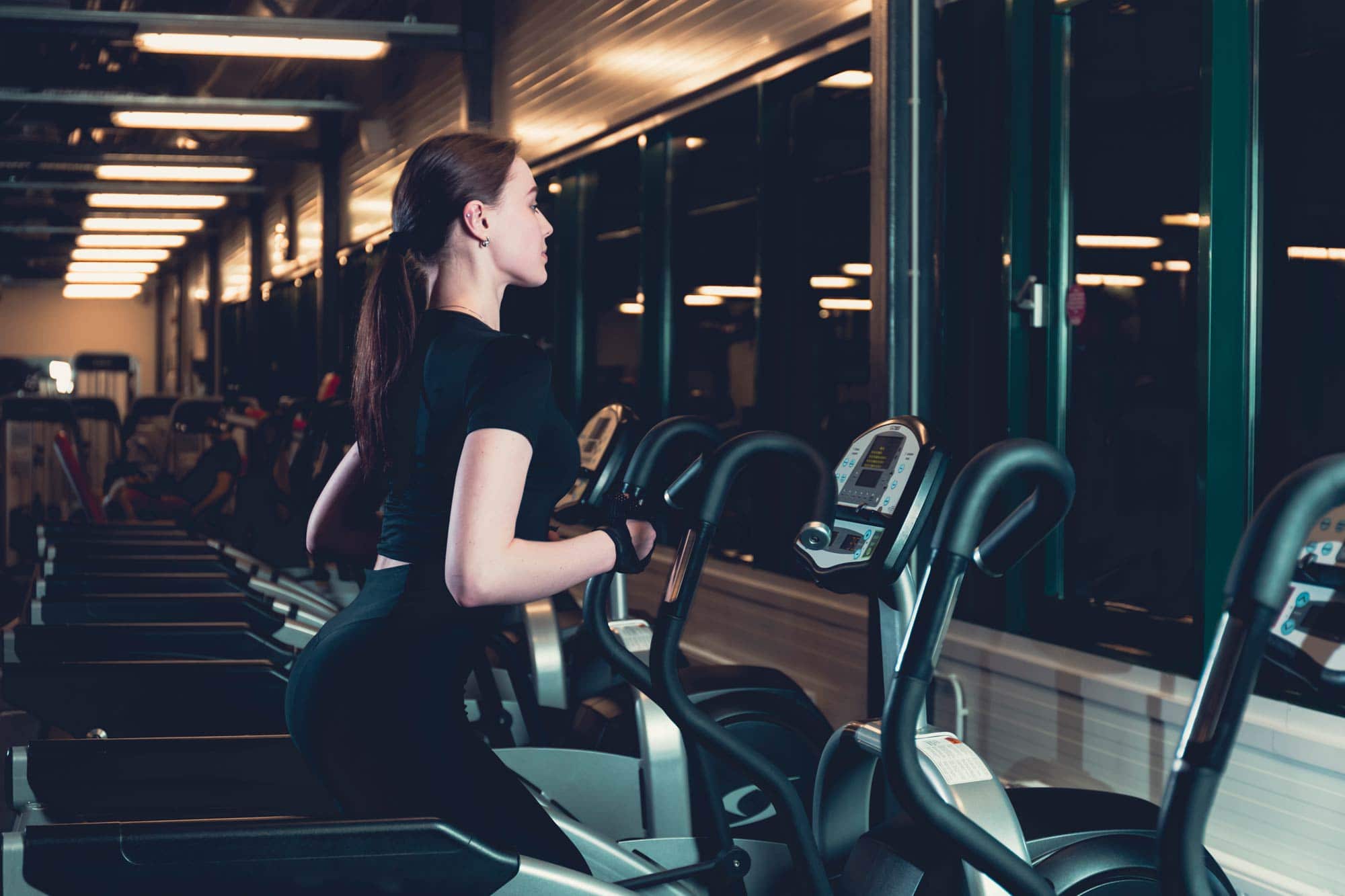
I can already see it — someone is reading this right now, rolling their eyes, and saying to themself, “There’s no way in HELL the elliptical should make a top 5 list for best cardio machines in the gym. I’m outta here!”
Well, before you shut this article down and miss out on some gems, I urge you to continue reading!
Easy to Use = Mediocre Results
The elliptical has become a fan favourite at a number of gyms around the globe and this is due to one simple reason: It’s one of the easiest cardio machines that you can use.
As we all know, people love easy! That’s why it’s so popular!
Sure — there are more than a handful of studies that prove the elliptical is “just as effective as walking on the treadmill”, but 1) the findings are muddled; 2) that’s only if you’re using it right, which we’ll discuss in a moment; and 3) that’s really nothing to brag about. 🙄
Furthermore, you’d never see someone who’s training for a marathon — or even a walkathon for that matter — using an elliptical trainer as preparation and that’s because, the fact is, it’s NOT as effective as walking, jogging, or running. It’s far less challenging actually.
If you’ve been in the gym for any significant amount of time now, you’ve probably realized that anything that feels “easy” usually doesn’t equate to much results — and the elliptical is no different.
Having Knee Problems? No Problem!
One thing the elliptical is absolutely great for, however, is a means of doing cardio when you’ve sustained some sort of lower body injury or are suffering from joint issues, such as knee/ankle pain, inflammation, or arthritis.
The elliptical is one of the lowest impact forms of machine cardio, meaning it takes a lot of stress off of your joints. I, myself, have used the elliptical as part of my cardio routine for months at a time when I was having issues with both my knees and ankles.
Again, it doesn’t necessarily produce the “best” results, but at least it still produces some results, which — when you’re committed to living an active lifestyle — beats hanging out on the couch all day. So, if you’re suffering with lower-body joint pain of any kind, rather than sit around and make excuses, just use an elliptical trainer instead. 😉
Best-Use Tips
For one, try using an elliptical with no hands. “ Ummm… what?!” is what you’re probably saying right now. But seriously, as weird as that sounds (or looks in your mind) give it a try!
People usually look at me crazy when I’m doing this at the gym and at first I wasn’t exactly sure why. Until I soon realized that no one else really does this, and people always give weird looks at things that are unfamiliar to them or they don’t understand.
Of course, there’s always a method to the madness!
Removing your arms and hands from the equation activates your core a bit more, making the exercise much more challenging. So, instead of easy = less results, you get challenging = better, more efficient results.
The second thing I would recommend is to up the intensity! It drives me absolutely crazy when I walk by someone at the gym and they’re absolutely GUNNING it on the elliptical machine — with a resistance and incline level of 1.
Don’t be a Superhero Elliptical Trainer. Not cool! 😄
You’re already using the easiest cardio machine in the gym. Don’t make it even easier, by making it even easier. That would be like sitting in on a Grade 1 math class as an adult and then answering all of the questions with a calculator. That would be silly, right?
Instead, up the intensity level, up the incline level, and challenge your heart to grow stronger! Afterall, that’s why you’re doing it in the first place, right?
The Bottom Line:
The elliptical trainer is great for individuals with lower body joint pain. If you are healthy and capable of using one of the other machines on this list, then do it.
2. Treadmill
Level of Difficulty: Easy to Hard | Focus: Full Body
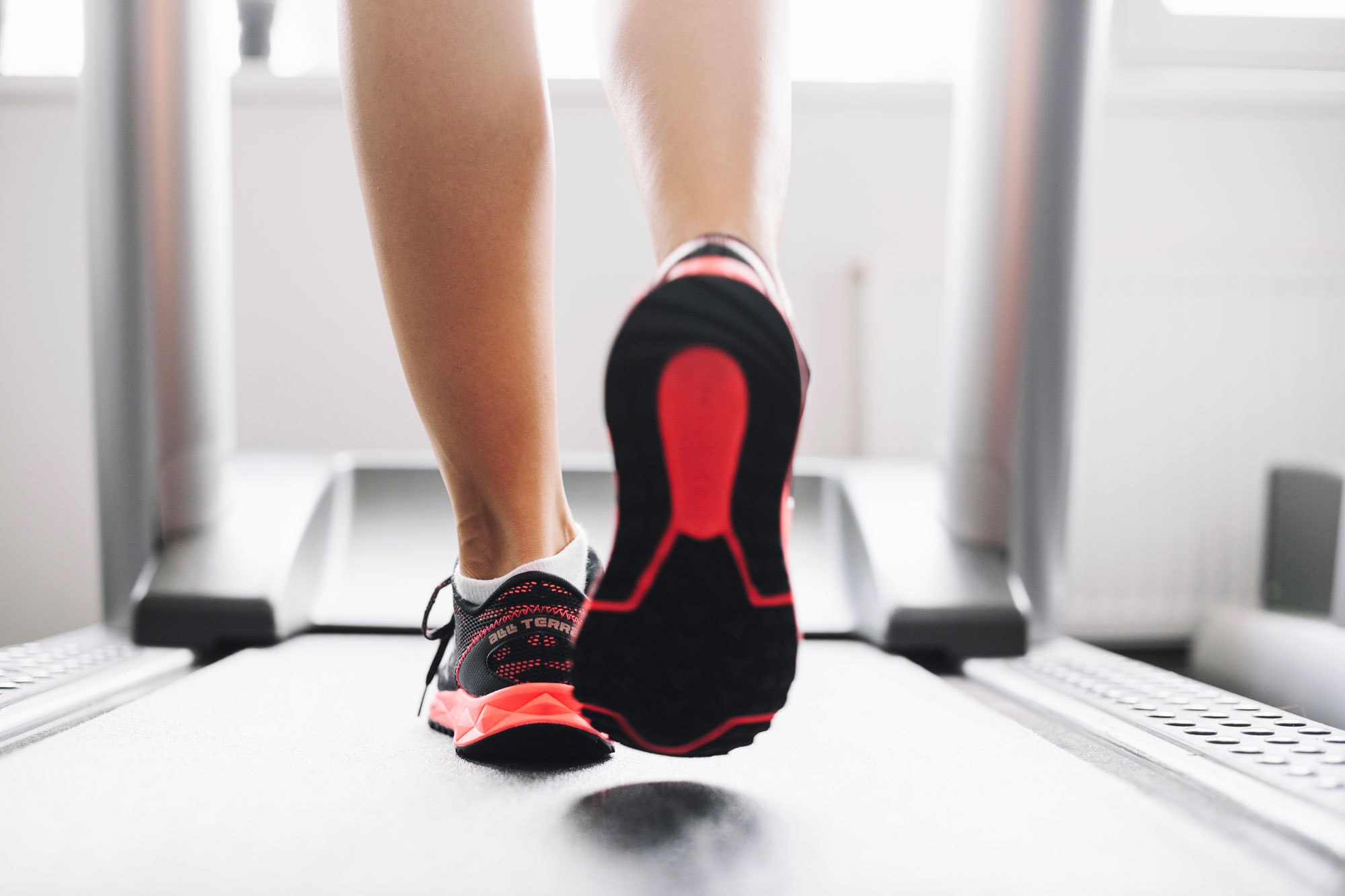
The treadmill (also known as the “dreadmill”) is personally one of my favourite forms of cardio, and it’s usually one of the most commonly used pieces of equipment in the gym (by individuals of all fitness levels), but that doesn’t necessarily mean it’s the best or most effective.
The Treadmill Is Great… When Used Correctly
Much like the elliptical, the treadmill can be extremely beneficial or a complete waste of your time, depending on how you use it. The key here, again, is to challenge yourself.
For the most part, everyone can walk. It’s one of the most natural human forms of exercise and activity. Sheesh! We’ve been doing it since we were toddlers!
Even as adults, we do it every day! We walk around our homes, we walk around the grocery store, we walk to the bus stop. Walking is a great form of exercise, but let’s face it — it’s not that hard.
If you’re walking on the treadmill as if you’re taking a stroll in the park, I have two questions for you:
- Why not just take a stroll in the park? It’s much more scenic; and
- Why are you wasting your time?! Remember: Cardio sucks! Be efficient!
When you get on a treadmill, you should be trying to make walking (or jogging) a more difficult or challenging task.
Ramp Up Your Intensity
As with the elliptical, you can do this in one of two ways
- by upping the speed of the belt; or
- by upping the incline level
Personally, I think the best option is actually a combination of options #1 and #2 — with more of a focus on #2.
I mean, think about it: What’s more challenging than walking? Walking up a hill. What’s more challenging than walking up a hill? Continuously walking up a hill for 15-60 minutes straight — that’s what! 😓
If you’re new to this, start off slow with a lower speed and gradually increase the incline over time until you can walk comfortably at maximum incline for your allotted amount of time.
Quick Word of Advice
Do not… I repeat… DO NOT… hold on to the rails while you’re using the treadmill.
When you walk around in normal life, do you have handrails to assist you? Of course not! So why would you use them while you’re on a treadmill?
If you have an injury and are undergoing physical therapy, this is obviously an entirely different story. However, for everyone else, hanging on to the handrails hugely negates the beneficial effects of the exercise and removes most of the difficulty.
As always, let’s do things right! Don’t be a Handrail-Holding Incline Treadmiller. Not cool! 😄
Of course, once the incline maxes out, the only way to keep challenging yourself will be by increasing the speed little by little, week by week. Adjust the speed as necessary, depending on your current goals.
In my opinion, this is the absolute most efficient way to use the treadmill as part of a balanced training program.
Also, I know people like to do all sorts of crazy accessory movements while they’re on the treadmill, but I think it’s important not to reinvent the wheel on this one.
There’s no need to break out anything fancy. Walking, jogging, or running with normal mechanics and normal hand movement will do just fine. 😄
The Bottom Line:
The treadmill is the gold standard of cardio equipment and provides a great full body workout. Remember to play around with the incline for best results.
3. Stationary Bike
Level of Difficulty: Medium to Hard | Focus: Lower Body
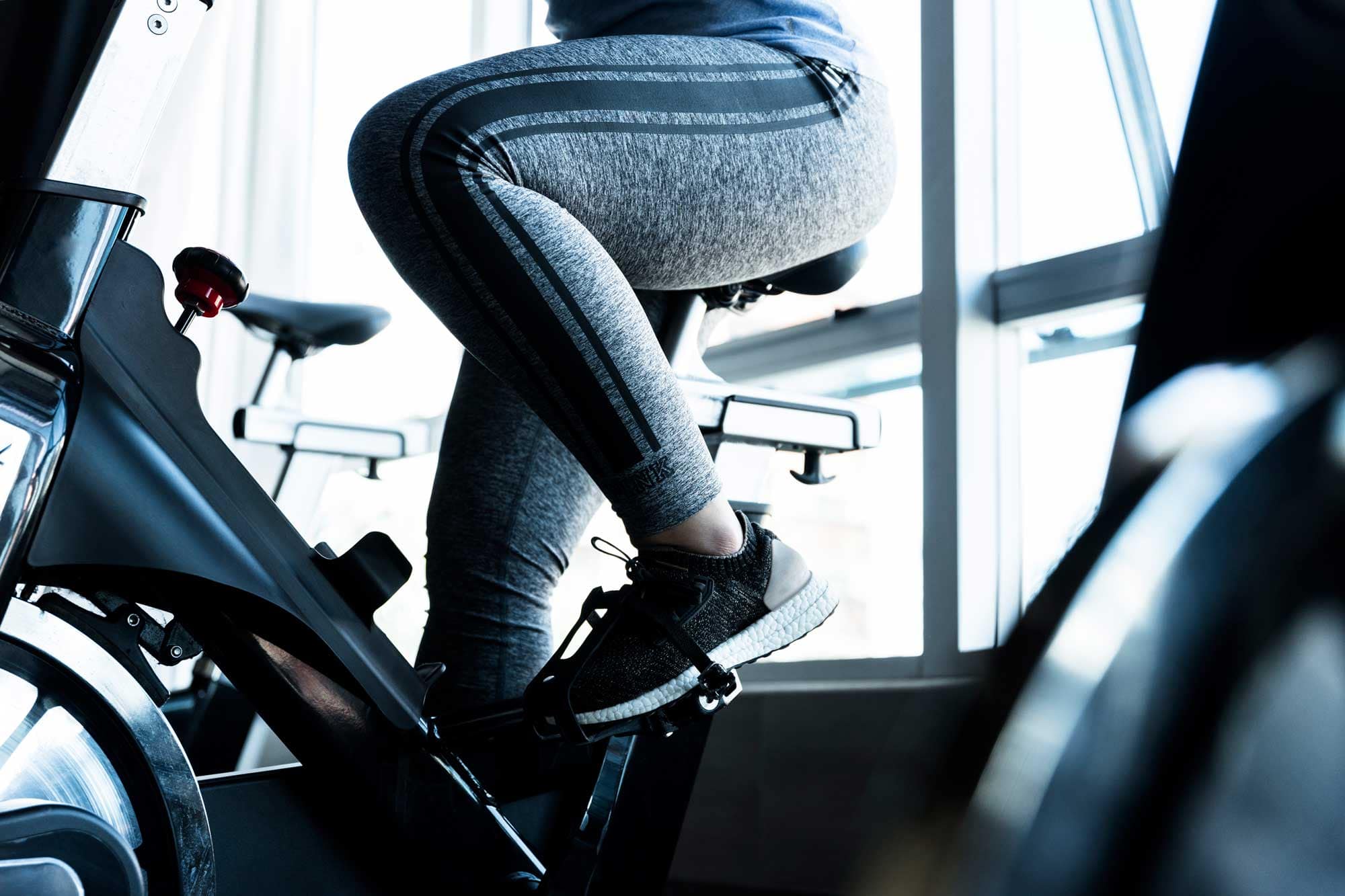
The stationary bike is a tough piece of equipment! It can handle anything you throw it at (go on… pedal away and see) and it’s an extremely challenging form of cardio, again, when performed correctly.
Naturally, there’s a complete focus on your lower body since your legs are literally doing all of the work. If one of your overall goals is to build stronger, more powerful, and better-looking legs, this cardio machine is definitely the one for you.
Now before I go into more details, I’d like to share a quick story with you about my personal experience with the stationary bike. If you don’t care about my story, that’s fine too. 😄 Click here to skip it.
Stationary Bike: A Love Story
All my life I’ve HATED the stationary bike. I know hate is a strong word, but, believe me, I actually mean it here in every sense of the word.
In late December of 2017, this was easily my least favourite piece of cardio equipment in the gym and the one I constantly avoided like the plague. I despised this even more than the stair stepper (which we’ll cover later on in this article).
I’m not really huge into new year resolutions, primarily because I think you should start achieving your goals as soon as you create them, but this fell in line with the timing, so I gave it a shot.
I set a goal of using the stationary bike every single day for 30 days and to include it as a regular part of my cardio routine for 2018.
Well, three things happened after that: 1) I became an amazing cyclist; 2) I accomplished my goal; and 3) The stationary bike is now one of my favourite forms of cardio. Crazy, right? 😄
I say all of that to say this: Don’t run away from cardio machines (or any other specific exercises in general for that matter) just because you don’t like them or you find them “too difficult” to perform.
Instead, attack your weaknesses, obliterate them, and turn them into strengths. This is when you get the best results and sometimes — as was the case for me and the bike — you even get to love something you once originally hated.
Choosing the Right Intensity
As with most of the machines we’ve talked about so far, the key here is intensity! You’ve got to be pedaling at a challenging enough pace for this machine to be of any benefit to you.
If you’re on the stationary bike and you feel like a little kid pedaling your way to the corner store on easy gear to grab some candy, it’s safe to say you’re going about this all wrong.
The good news is, finding the right intensity level isn’t very hard.
Let’s say you’re planning on cycling for 30 minutes, the intensity shouldn’t be so difficult that you want to quit after 5 minutes; however, it also shouldn’t be so easy you could cycle at that pace for 5 hours.
Riding the stationary bike is a really, really tough exercise and it should feel that way! Especially when you’ve got that resistance level cranked up to the sweet spot.
Work Those Legs, Baby!
Compared to the elliptical or treadmill, the stationary bike places a tremendous amount of tension on your quads, hamstrings, glutes, and hip flexors (specifically in that order) with a little help from your calf muscles.
The increased workload on the hamstring muscles is especially greater than that of any other cardio machine; hence, the potential for such amazing leg development.
Lastly, engage your core and try to keep upright throughout the entire exercise. If need be, use the handlebar to avoid hunching over while you’re cycling. Unlike the other exercises, this is totally fine and doesn’t have any negative effects on efficiency.
Part of me wanted to rank this #2 on the list because of my new found love and bias for it, but I believe it earns it’s true rank at #3.
The Bottom Line:
The stationary bike is the ultimate endurance and leg builder. Remember to ride steady and consistently — pace yourself. Bonus: It’s also fairly easy on the joints.
4. Rowing Machine (Rower)
Level of Difficulty: Medium to Hard | Focus: Lower Body
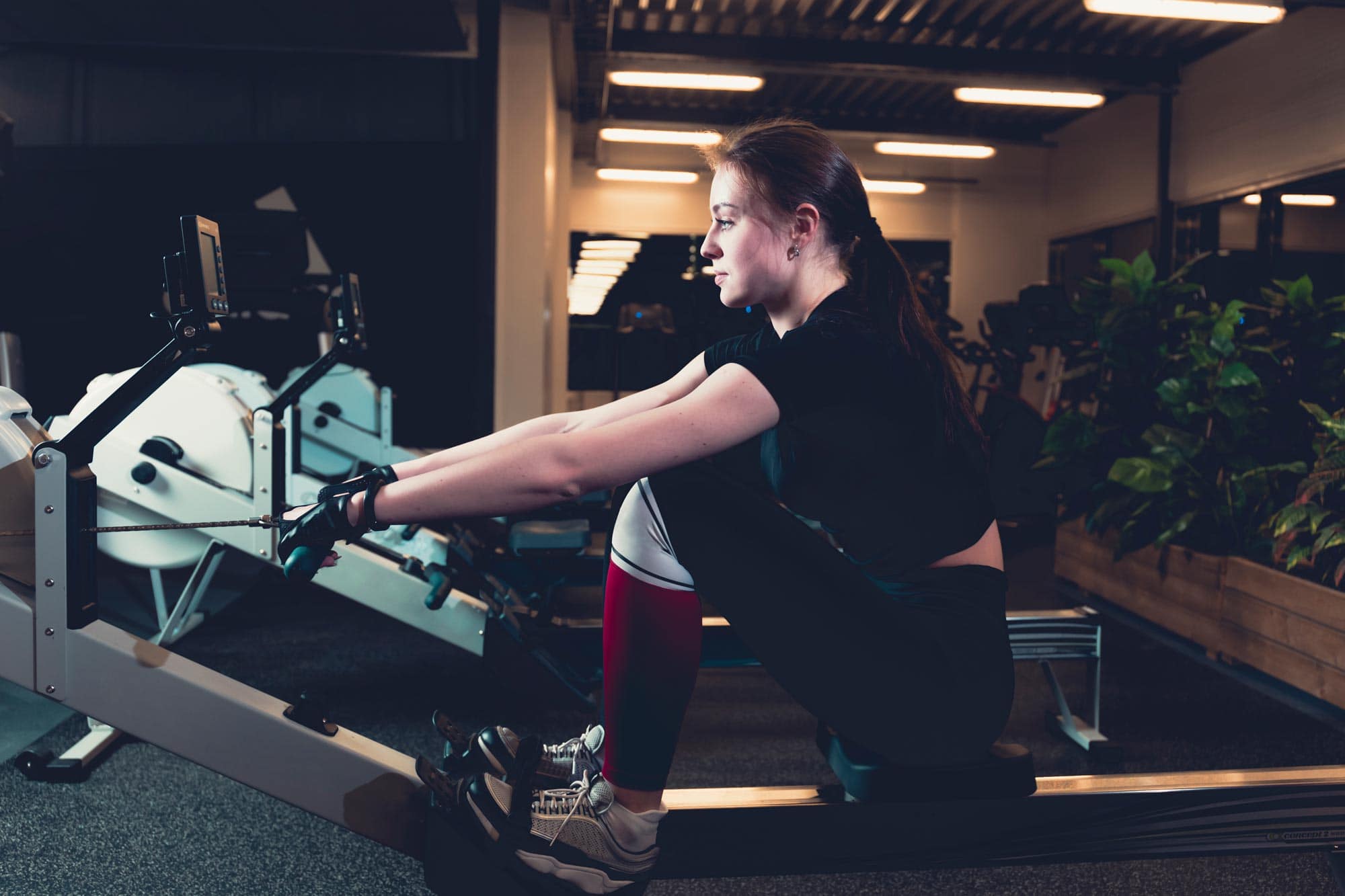
The rowing machine is another amazing piece of cardio equipment that most people shy away from for a number of reasons:
- Rowing machines are just not very popular and most people are followers; they like doing what everyone else is doing
- Rowers are extremely challenging to use, especially for longer sessions
- There’s a significant learning curve compared to other cardio machines and you need to learn the correct form for the exercise to be effective
- People are intimidated because of reasons #2 and #3
The Rower Provides a Full-Body Workout
The rower provides a true full-body cardio workout, as your lower body, core, and upper body are all fully engaged throughout the entire workout.
In fact, instead of running down a long list of muscles that rowing engages, it would be much easier to fork out a list of muscles that it is does not engage — which isn’t very many.
Rowing is also one of the best forms of machine cardio because of the fact that it is virtually zero-impact and non-weight bearing. As is the case with the elliptical, this makes it absolutely perfect for anyone with joint pain or injuries.
Given the fact that rowing is the tougher of the two exercises, it easily beats out the elliptical in terms of efficiency, but, of course, each person’s individual needs and situation differ, so it’s important to pick the one that’s right for you.
Also, the rowing machine isn’t just great for people with injuries; it’s an excellent cardio machine to use for any occasion!
Since I’ve got the rowing machine listed as second best in this article, it should be pretty obvious that it does an amazing job of getting your heart rate revved up and burning lots of calories. In addition, once you learn the correct rowing technique, it’s easily the most fun machine of the bunch.
Now, since this article is also partly about helping you understand how to make better use of all of these machines — and in hopes of inspiring more people to use this wonderful piece of gym equipment — let’s dive into a quick overview of the four basic phases of a rowing stroke for those of you who don’t know them. If you’re already familiar with proper rowing technique, click here to skip ahead.
How to Row Like a Pro:
- The Catch — This is the initial stage of the rowing stroke. The seat should be slid all the way forward with your knees bent and you should be positioned at the very front of the machine. To perform the catch, bring your knees all the way in towards your chest while keeping your shins straight and parallel. Hold your arms straight out in front of you while grasping the handle bar and hinge forward at the hips so that your upper body is leaning forward while still keeping your chest up and your back straight.
- The Drive — The second phase of the rowing stroke is known as “the drive” and is initiated by pushing off of the foot plates to begin a full extension of your legs. At the exact same time, use your core to hinge backwards at the hips, this time aiming to bring your upper body to a completely upright position.
- The Finish — During the third phase, the finish, you’ll be using your core to stabilize your body while hinging slightly backwards at the hips. At this time you will also use the momentum you created in the drive phase to extend your legs all the way fully while simultaneously pulling the handle bar all the way in towards your sternum (center of your chest).
- The Recovery — The fourth and final phase of the rowing stroke, the recovery, is essentially the first three steps performed in reverse. Extend your arms back out in front of you, hinge forward from your hips, and bend your knees to pull your seat forward and return you to the initial “catch” position. Be sure this is all done in a controlled manner, just as you would do with a negative rep when resistance training.
As you can see, throughout each and every phase, different muscles are being used to carry out the movements. In fact, completing just one rowing stroke activates every major skeletal muscle in your body.
If you’re looking to improve your cardiovascular health and burn calories efficiently all while engaging in a true full body workout and having lots of fun, then the rowing machine should be a staple in your weekly cardio routine.
The Bottom Line:
The rowing machine is going to provide you with the best full body work out of all of the machines on this list. Learn the right technique and reap your rewards.
5. Stair Stepper (StairMaster)
Level of Difficulty: Medium to Hard | Focus: Lower Body
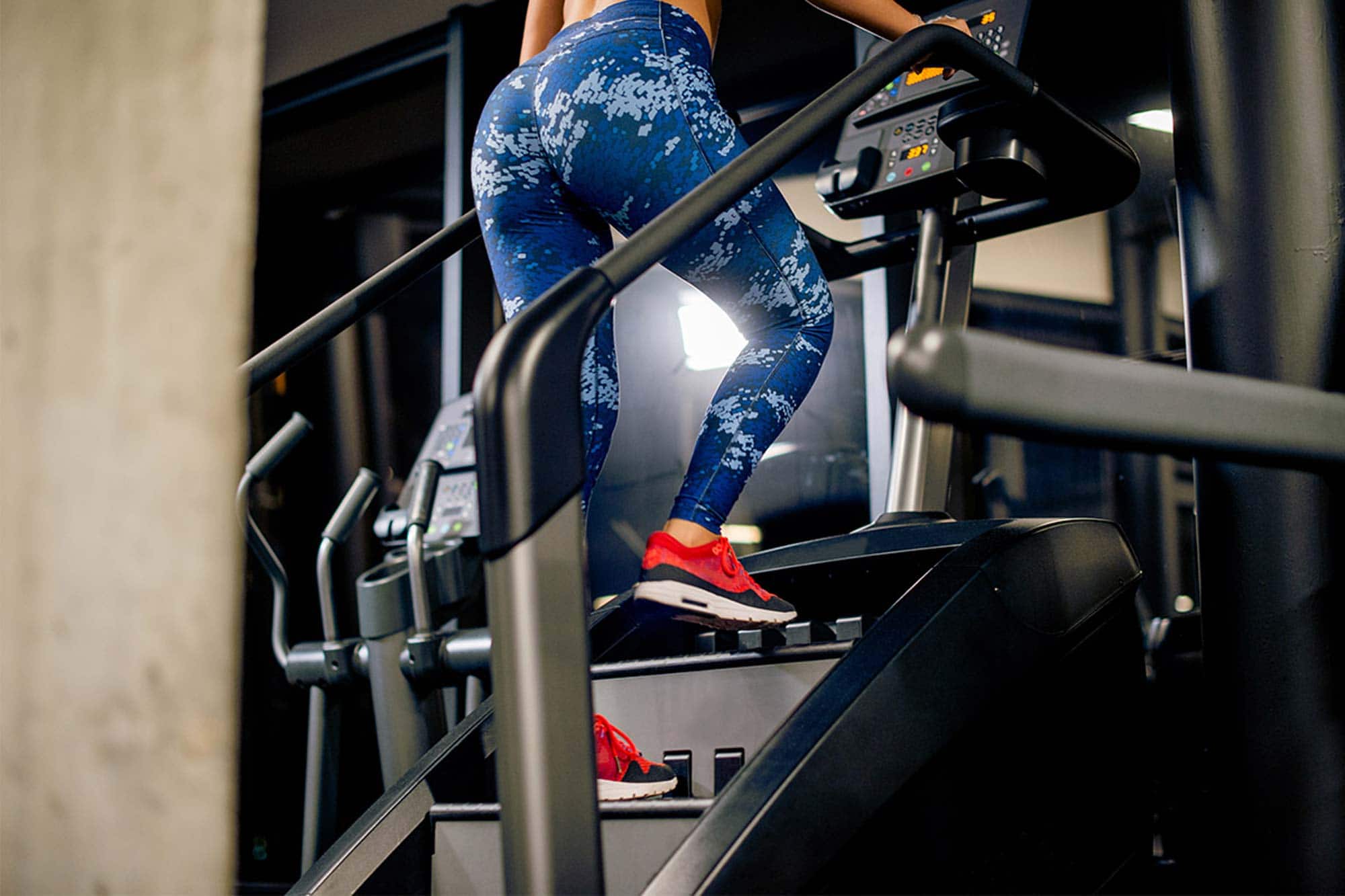
Ahhhhhh! As always, the best is saved for last — the infamous stair stepper.
The stair stepper produces almost the complete opposite scenario of the elliptical. Instead of being the most liked, it is the most feared.
Everyone and their mother run away from this machine and the reason is clear: The stair stepper is one of the most challenging forms of machine cardio in the gym — point, blank, period.
The Toughest Cardio Machine in the Gym
Why? Just think about it: What’s more challenging than climbing a set of stairs? Climbing a never-ending set of stairs for an extended period of time — that’s what! 😓
It’s tough, it’s challenging, it’s gruesome. If you’ve ever lived or worked in a building with no elevator, even when you’re in the best shape, then I’m sure you know how challenging it can be to climb even just a few flights of stairs!
For me, personally, climbing stairs never gets any easier and it definitely never feels “fun”. And if an exercise meets those two criteria, it’s usually a great indicator that it’s producing the best results.
Don’t believe me? Let’s compare this to two of the most beneficial compound lifts: squats and deadlifts.
These lifts are ALWAYS challenging! No matter how good you get at them, you can never seem to love them. You might like ‘em, but you’ll rarely ever love ‘em! And if you’re one of the few who does, it’s simply because you’re aware of the results that lay ahead.
Do It Right or Don’t Do It at All
The stair stepper is easily the most misused cardio machine in the entire gym and I’m here to put an end to that right now!
Once again… STOP HOLDING ON TO THE HAND RAILS!!!
This is just as much of a pet peeve for me as the Superhero Elliptical Trainers and the Handrail-Holding Incline Treadmillers. You look plain silly; it’s just no one has told you because they’re all just as sillily (Is that even a word? Hahaha! I actually looked it up and it is!) doing the same thing!
I remember when I first told my mom about this and she decided to make the switch. She said, “Does it really make that much of a difference?”
The next day, she put it to the test and was in absolute awe because of how much more difficult the exercise became.
She asked me, “How am I supposed to do this without holding on?” To which I replied, “Just lower the speed, mom.” 🙂💖
Take It Step by Step
No pun intended! As we’ve all been told a thousand times (or more), “You can’t run before you can walk!” And the stair stepper should follow the same principle.
Why people increase the stair stepper to ridiculously high speeds and then hold on to the hand rails for dear life is beyond me.
Just as I discussed with the treadmill, increase the speed when, and only when, you’ve become completely efficient at performing the exercise at a specific speed for an allotted amount of time. Otherwise you’re just negating the effectiveness of the machine altogether.
Don’t believe me? Try it out yourself the next time you’re at the gym and leave a comment below with your findings.
Look, if you can’t perform speed level 10 for 30 minutes without holding on, then drop it down to speed level 5. If you can’t perform speed level 5 for 30 minutes without holding on, then drop it down to speed level 1!
Our bodies are amazing pieces of biotechnology that adapt at an extremely rapid rate. You will eventually be able to go faster in due time — the right way!
Who cares how fast the dude or lady next to you is going! And who cares what anyone thinks about how slow you’re going! Because now you know they’re doing it the wrong way and you’re doing it the right way! That’s what counts most!
Don’t be a Silly Speedy Stair Stepper. Not cool! 😄
The Bottom Line:
The stair stepper is infamous for a reason. Hard work = BIG results. This is easily your #1 choice if you want to build your legs and glutes while blasting away fat.
Need Help With Your Training Program?
Do you want a custom-built fitness program that doesn’t include hours and hours of boring machine cardio at the gym each week and that still gets results?
Not sure where to begin? Let us help you discover your path to better health.
In our MyQuest Coaching program we perform a comprehensive needs assessment and then build you a fully-customized fitness program tailored to your every need.
This includes the implementation of a completely personalized training program that will keep your machine cardio sessions to an absolute minimum, and much more.
If this sounds interesting to you, click one of the buttons below to get started:
Apply for Coaching TODAY!
Because yesterday you said tomorrow.
Final Thoughts
Hopefully you’ve learned that the best machine for cardio obviously depends on your individual goals, needs, and preferences. As with most things, there isn’t a one-size-fits-all.
Personally, I use a combination of all of the cardio machines mentioned here on a weekly basis, as it’s important to switch things up and keep the body guessing.
In the warmer months, I’d much prefer to get outside and go for a jog, run sprints, go on hikes and walk trails, climb hills, and play outdoor tennis. But when the winter months cramp my style, machines are what I use to get the job done.
I’m interested: What are your thoughts? Do you agree with me on any of this? Do you disagree with me? What do you personally think the best cardio machine is and why? How about the worst? Leave a comment down below and let me know!







